Richmond Takes Long Awaited Steps Toward More and Better Soccer Fields

See Pg. 3


See Pg. 3
A former police officer who now teaches at the high school she attended created the Youth Public Safety Academy to give high schoolers training and mentorship from Richmond first responders. The first graduating class walked the stage June 29.
Carmen Santana, a Richmond High alumna, former Richmond Police officer, and current Richmond High teacher, partnered with local public safety departments to create the Youth Public Safety Academy. Participating high school students undergo an eight-day crash course in physical, self-defense, law and basic training and graduate with a CPR certification. The instructors are Richmond emergency medical services providers, firefighters and police officers, who volunteer to mentor the youth during and after the program.
“I am doing this to be that mentor that I needed when I was in high school. As a teacher, I noticed that many of these kids haven’t thought of goals for the next year or what they want after high school,” said Santana. “Our goal is to teach them life skills that they are going to need in any job: time management, discipline,
Have questions, comments, or want to get involved?
Contact Richmond Pulse at:
info@richmondpulse.org

accountability, responsibility and respect.”
Santana said there is a lack of resources and mentorships specifically for minority groups, which can make young people in these groups feel like there aren’t opportunities for them. She saw this as a police officer.
“Out of 187 officers, 15 were women, and out of those 15, only three were Latinas. The same thing happens with sexism,” she said. “Some people say women can’t do these jobs. There are women firefighters, doctors, police officers and military personnel. But we don’t see it enough, so the youth don’t see it as a possibility.”
According to the Office of Juvenile Justice and Delinquency Prevention, mentoring youth “can help support the positive development of youth. Mentoring has been shown to improve selfesteem, academic achievement, and peer relationships and reduce drug use, aggression, depressive symptoms, and delinquent acts.” Although many youths receive mentoring, “many more do not.” Additionally, quality mentorship has even greater “impacts on youth outcomes.”
“My goal is to place these kids with the right mentorship for their goals that will help them follow any profession that they choose. If we start now, we can guide
youth to better positions and make them great leaders.”
At the graduation, it didn’t seem like the students had only received 64 hours of training. Uniformed and disciplined, they marched as one to and from their seats, only smiling to the audience of family and public safety personnel as they received their certificates.
“These kids were shook. They were startled. They had no idea what they got themselves into, and I didn’t know what I got myself into. I saw a big challenge with these kids,” said mentor Adam Ramirez, Richmond Fire Department’s Firefighter of the Year.
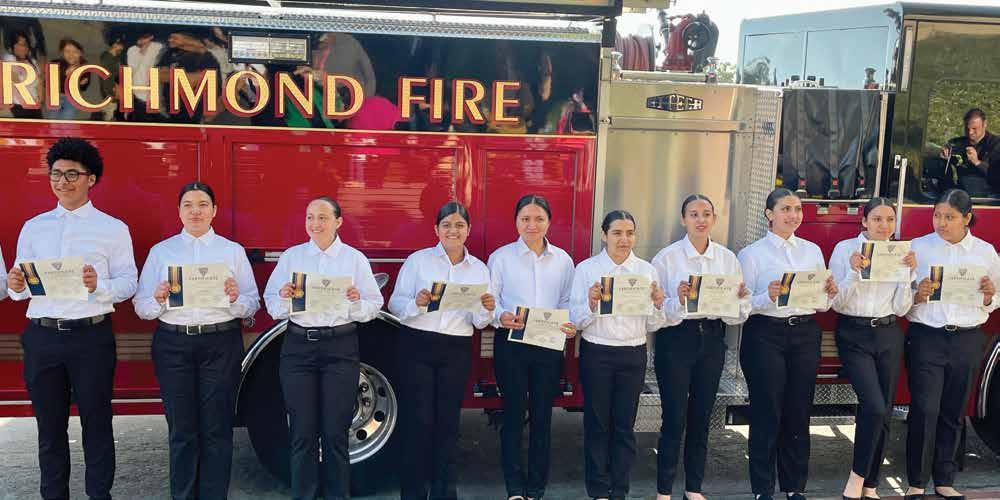
The academy began with 28 students, according to Ramirez. Of those, 18 graduated.
“The training is not for everyone, but they were able to accomplish this through hard work and sacrifice,” he said.
Daniel Carlos Cuellar, a 16-year-old high school senior, was one of the graduates.

“Honestly, it was really hard, but it taught me to just keep on pushing. They did push me to failure, but they also kept encouraging me to keep going. It helped me mentally and physically,” he said.
He joined the academy because he is interested in working in the criminal
justice field.
“It has been one of my dreams since I was in elementary school. This program helped me gain resources and have a better understanding of what I am willing to do in the future to pursue it,” he said. “I gained a mentor, and I appreciate all the advice they are giving me. I know I can come to them for any questions I have.”
Sofia Pereda Zanni, a 16-year-old incoming senior, learned about the program through her brother. She was very interested when she learned that she would train and receive a CPR certification.
“I was unsure about public safety at first, but this program showed me I could lean more towards medical or EMT,” she said. (EMT is short for emergency medical technician.)
The experience was somewhat familiar to Rene Cea, an incoming high school senior, who learned about the program from Ramirez.
“Coming into this program, I had already had some basic training from attending the Richmond Youth Academy for firefighter cadets,” Cea said.
The familiarity did not make the experience easy, however.
“It is no joke when I say they pushed
Publisher Malcolm Marshall
Editor
Danielle Parenteau-Decker

Ana Tellez-Witrago
Sasha Abigana
Michael J. Fitzgerald
Joe Porrello
Samantha Kennedy
Nadia Lathan
Denis Perez-Bravo
Vernon Whitmore
Sandy Close
Michael J. Fitzgerald
F rom Division I athlete to public transportation board member, longtime Richmond resident Jovanka Beckles has walked in all kinds of shoes. Next fall, she hopes to step into a new pair: California state senator.
The former Richmond City Council member launched her political campaign this summer and is running on a platform of affordable housing, subsidized public transportation and free childcare for Senate District 7. She’s placing a firm foot down amid a crowded field with Berkeley Mayor Jesse Arreguín, Oakland City Council member Dan Kalb and labor organizer Kathryn Lybarger all vying to replace Sen. Nancy Skinner.
Beckles believes her strength comes from her identity. A queer, Black Latina with immigrant roots in Panama, the current AC Transit board member is steadfast that her background will best represent the district she hopes to serve. Beckles was born in 1963 in Panama and her family immigrated to the United States when she was just 9 years old in 1972. Shortly after attending college at Florida A&M University, Beckles moved to the Bay Area in 1989 where she began her career as a mental health clinician.
“We’ve never had anyone to represent us from Richmond, and this is our opportunity to do it,” Beckles said in an interview with Richmond Pulse.
We sat down with the District 7 candidate to talk about her campaign and, if she succeeds, the changes she wishes to enact as California’s third Black state senator in history.
Responses have been edited for clarity and brevity.
Richmond Pulse: From your time on City Council to the AC Transit Board of Directors, you have an extensive history of serving the greater Richmond community. What inspired you to run for state Senate?

Jovanka Beckles: I was inspired by just understanding how much an elected official, a public servant, who actively engages with the community, what we can do together. I’ve seen the types of legislation that can come about as a result of that. And so I’m really inspired to take that level of organizing to the California Legislature.
Another reason why I’m inspired is equity. The California state Senate has 40 seats, and out of those 40 seats, there are only two Black people on there — two Black senators. That’s out of 40. And one male, one female. That absolutely does not reflect the diversity of the state, and it absolutely does not reflect the diversity of this region.
RP: In a few sentences, how would you summarize the purpose of your campaign and the goals you wish to achieve as senator?
JB: The purpose is for us to have representation as people of color, to have representation for Black folks, to have representation for immigrants, to have representation for the LGBTQ community, to have representation as women. And, for someone like me who’s had a 34-year career as a mental health provider, and for us to have this legislation at the state level that would address people’s mental health challenges.
Many of the policies that I champion are to help renters and homeowners stay in their homes. Those are the kinds of policies I want to continue to champion at the state level. Just from having spoken to many of my constituents here in Richmond, we need a Green New Deal.
RP: How have the prior roles you’ve had — most notably, as a mental health specialist for 34 years — influenced your approach to assessing a community’s needs?
JB: Families need to be able to have employment that can help them pay for rent. They have to be able to have a
place to live. They have to have beautiful parks to go to. During my tenure on City Council, Richmond’s parks were renovated, we have bicycle lanes, roads were fixed, libraries were open longer. People were given the resources they need to put down their guns and go to work. And so it’s through that lens that will continue to inform my decision making as Richmond’s next senator.
RP: How do you envision your work on the AC Transit board translating over to your time as a senator? What are your priorities when it comes to advocating for public transportation?
JB: A lot of the budget comes from state funding and federal funding. And so that translates in that when we have representatives in the state Legislature who are going to prioritize public transportation, then that means prioritizing our budget to be able to fund transportation.
When we have to reach these climate goals within 10 years, then we have to take drastic measures to make sure that people get out of their cars and we reduce our carbon footprint. And the only way people are going to be able to get out of their cars is if we have, first and foremost, public transportation that’s reliable and that’s affordable and the infrastructure to support that.
RP: You mention on your website that the East Bay deserves a senator whose lived experience reflects their own. Can you talk more about your identity and how it influences the policies that you support?
JB: I am the most diverse candidate running in this election. Black. Latin. Immigrant. Queer. Woman. Mental health professional. I feel like all of the challenges that we’re having today can really be solved with someone who has that lived experience in this body and this identity.
RP: How did some of the backlash you
See Beckles, pg. 6

Richmond police have released video of officers shooting and killing a man in Point Richmond while serving a search warrant in June.
They also found 53 firearms inside, including 23 pistols, eight revolvers, 20 rifles and two shotguns.
There was also a live hand grenade, a large quantity of ammunition, and materials to manufacture illegal firearms, police said.
Video released by Richmond police in early July shows officers shooting and killing Kevin McDonald, 63, of Richmond on June 28.
McDonald was shot when he allegedly pointed a gun at police while they searched the home in the 1200 block of Sanderling Island.
Police were initially investigating 63-year-old Jose Martinez, who also lived at the residence and was arrested earlier that day, accused of brandishing and firing a weapon the previous weekend in Point Richmond.
Martinez allegedly had a firearm in his vehicle when police pulled him over at
4:09 a.m. June 28 on Interstate 580, near Regatta Boulevard.
Police said Martinez admitted to possessing firearms in his bedroom and told police he lived at the home on Sanderling Island.
Police said Martinez had prior felony arrests that would prohibit him from possessing firearms.
Officers arrived at the home with a search warrant to retrieve Martinez’s weapons at 9:08 a.m. on June 28.
Bodycam video released by Richmond police shows officers knocking on the front door and making numerous announcements identifying themselves, while demanding entry. They eventually entered using a key provided by Martinez.
The video shows officers searching the house and repeatedly called McDonald by name, asking him to come downstairs. They announced themselves as police before opening McDonald’s bedroom door. An officer yells “gun” and shots are fired. Part of McDonald’s body and at least one gun is visible in the video. Police said McDonald raised an AR-15-style pistol
before police fired.
McDonald was pronounced dead by responding medical personnel.
Like Martinez, McDonald had a prior felony conviction prohibiting him from having firearms.
Martinez is accused of brandishing a firearm at pedestrians at 8:47 p.m. June 18 in the 900 block of West Cutting Boulevard.
He’s also accused of brandishing a firearm at pedestrians, and firing the weapon, at 1:32 a.m. June 26 in the 100 block of Washington Avenue.
The Contra Costa County District Attorney’s Office filed nine felony charges against Martinez June 30, including assault with a deadly weapon, brandishing a firearm, and illegally possessing a firearm.
Copyright © 2023 Bay City News, Inc. All rights reserved. Republication, rebroadcast or redistribution without the express written consent of Bay City News, Inc. is prohibited. Bay City News is a 24/7 news service covering the greater Bay Area.•
Nestor Fantini was beaten, tortured and held captive for four years as a political prisoner in Argentina in the 1970s — one of many arrested or killed for opposing the country’s military dictatorship.
And he said the likes of what he went through is still going on.
“What happened in Argentina is still happening in so many other parts of the world,” Fantini said during a June 9 discussion hosted by Ethnic Media Services that asked, “Can Communities Heal from Hate?”
As EMS co-director and panel moderator Julian Do put it, there has been a “relentless rise in racial and ethnic hate crimes,” including “brutal attacks on Asian Americans … targeted shootings of African Americans … Jewish worshippers at a synagogue and LGBTQ persons … cultural genocides of Native Americans … countless attacks against Latinos.”
Activist Helen Zia said the current levels of hatred and violence also harm people by resurfacing old wounds.
“This is a time of incredible change, tectonic shifts that are going on that, unfortunately, have involved violence, division and things that have resurfaced, a lot of the triggering that brings back intergenerational traumas,” she said. “The thing about these traumas, even if they are incidents that have happened long ago, they continue, they’re absorbed, not only in our psyches but our bodies.”
Zia said many Asians living in the U.S. came here as refugees — trying to escape violence. That includes Do’s own family, who came to the U.S. as refugees at the end of the Vietnam War.
Now, Asian families have to face “the uncertainty of walking out your door and possibly be killed,” she said, “or having Grandma and Grandpa go for a walk and wondering whether they’re going to come home at all.”
Uncertainty also comes in the form of some tough questions.
“How do people and communities find a way to reconcile with horrific acts perpetrated against them, their families, their communities, let alone the ongoing trauma of structural racism and wars, of genocide or states-induced terrorism?” Do asked. “Is there a way to heal?”
For some people, like the mother of Vincent Chin — a Chinese American man killed in Detroit by two white men in 1982 — it can help to be “able to channel their grief through action to make a difference,” Zia said.
At the time, the U.S. automobile industry was struggling against competition from Japanese automakers. “And Japanese Americans — or anyone mistaken for them — became scapegoats,” wrote Harmeet Kaur for CNN.
That attitude reportedly motivated autoworkers Ronald Ebens and Michael Nitz, who beat Chin to death.
Ebens and Nitz ultimately pled guilty and no contest, respectively, to manslaughter charges but spent no time in jail.
But Chin’s death did lead to change, including “a new civil rights movement,” according to Zia.
She said there were “not just Asian Americans coming together but reaching out and joining with the Black commu-
nity — Black, brown, red, white — and coming together and actually saying, ‘We stand together against hate and inequality and injustice to any community.’ ”
According to Zia, people came together across generations, religions and cultures.
This helped people understand how different traumas experienced by different groups over hundreds of years are linked, she said.
“Naming different communities as the enemy,” on the other hand, “divides us, keeps us apart and makes it less possible to actually make change, and it is the change that is healing,” Zia said. “Healing, it also means empowerment.”
Professor James Lance Taylor of the University of San Francisco also spoke of the “solidarity that is needed to break down barriers, helping people understand in their own terms what other groups have experienced.”
Taylor is a member of the San Francisco African American Reparations Advisory Committee.
“What reparations is about is, is really about healing and reconciliation and fixing the broken bone to repair, to repair a people,” he said.
He said that reparations would be good not just for the descendants of enslaved people or Black people, in general, but also for the entire country.
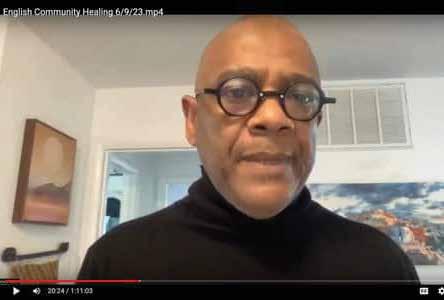
“I think America’s great moment is still ahead of itself. If it did reparations, it would heal this land. It would heal this land in a tremendous way,” Taylor said. “It would heal Black America, the crime, the poverty, the negativity, all the social problems.”
Beth Wright, an attorney with the Native American Rights Fund, was supposed to speak about the lasting damage caused by the boarding school system that many Native children were forced into, but she was quickly cut off by technical difficulties.
Do relayed what she was going to talk about from a conversation he had had with her.
“When these children were kidnapped and placed in these boarding schools, they basically robbed many of these tribes of the cultures, the language and the identity,” he said, “so part of the restorative justice is about restoring the
tribes’ identity and also the culture and also the languages as well”
Fantini, the former political prisoner, said that restorative justice and reconciliation are only sometimes the answer.
“Don’t get me wrong. I strongly support reconciliation … and also restorative justice programs because they are a humane alternative to a very dysfunctional criminal justice system,” he said. “How could we not support restorative justice programs that are a true alternative to punishment, to revenge?”
However, he said, a one-size-fits-all approach does not work.
For reconciliation or restorative justice to be achieved, Fantini said, “it’s fundamental that the offender needs to acknowledge the harm that he or she had caused.”
He said that has not happened in Argentina. “There’s no acknowledgment. There’s no shame. There’s no apology,” Fantini said, likening it to Holocaust denial.
If the offender does admit their wrongdoing, they then need to provide both “material restitution and symbolic reparation,” he said.
Fantini said it is especially important that the perpetrators of hate crimes be held accountable and that “next generations know what actually happened.”
“It’s so important to talk about the past experiences to understand what we should do in the future,” he said.
Zia also stressed the importance of not letting history repeat itself.
“They say that time heals all wounds, but I don’t think time … time is not enough,” she said. “There must be action. There must be learning. … We must know the past and acknowledge the past … so that we don’t repeat it in the future.”
This resource is supported in whole or in part by funding provided by the State of California, administered by the California State Library in partnership with the California Department of Social Services and the California Commission on Asian and Pacific Islander American Affairs as part of the Stop the Hate program. To report a hate incident or hate crime and get support, go to cavshate.org. •
BY SAMANTHA KENNEDYIn front of the largest crowd since resuming in-person meetings, the Richmond City Council took action July 11 on an issue the public has been waiting on for decades.
The council directed city staff to move forward with planning for more in-city soccer fields. That includes beginning efforts to reach an agreement with the West Contra Costa Unified School District to use its facilities, getting community input on potential soccer fields, and having staff check on complaints about bathrooms. Support from the council was unanimous.
For many in Richmond, lack of access to adequate soccer field facilities has lasted for generations in their families.
Diego Garcia is one of them. Garcia, who serves as president of the board of Richmond’s semi-professional soccer club, Richmond Sol, told the council during public comment that he has been asking for the same thing for over 20 years since his son was a kid.
“We came here, and this board promised us some fields.” Garcia said. “My son is 25 now.”
Soccer fields in Richmond are scarce. The 2010 Richmond Parks Master Plan showed that only two of the soccer fields used were intentionally designed to be used as such. There were 16 fields in total being used at the time, and staff found that an additional 19 were needed to properly serve the community. Due to population increases, it’s likely more are needed now.
Samantha Torres, who serves on the Recreation and Parks Commission and as a coach for the Richmond United Soccer Club, gave a presentation that advocated not just for the creation of more soccer fields but for their proper care.
Already limited soccer fields further reduce participation in the sport because the facilities are not maintained correctly. Teams outside Richmond don’t want to play on potentially dangerous fields, and Richmond teams don’t have the resources to help their players make progress towards their goals.
Those goals include becoming a professional soccer player.
Amelia Torres is 10 years old and wants to play soccer professionally when she grows up. Amelia spoke during public comment, asking the city to fix things like the holes in Nicholl Park that have caused injuries to her teammates.
Even in the often poor conditions they are in, Richmond parks charge higher rates for usage than surrounding cities. Rates continue to increase if users want to use lights or have access to the bathroom.
Facilities outside of Richmond are much more attractive but many organizations are unaware of them. One facility, the Tom Bates Regional Sports Complex in Berkeley, was agreed upon for use by five cities in 2003. Rates are lower and maintenance is better, but, according to Samantha Torres, there has not been enough outreach to inform the
A soulful group of artists performed at the 12th annual North Richmond Music Festival organized by the North and Greater Richmond Blues Foundation at Shields-Reid Park on July 15.
Following introductions by event host DeJeana Burkes, musicians Silk-E, Reggie Rolls, Lady E, Alvon Johnson and Rhonda Benin took turns performing alongside the Best of the Bay 2023 Festival Band from noon until evening.
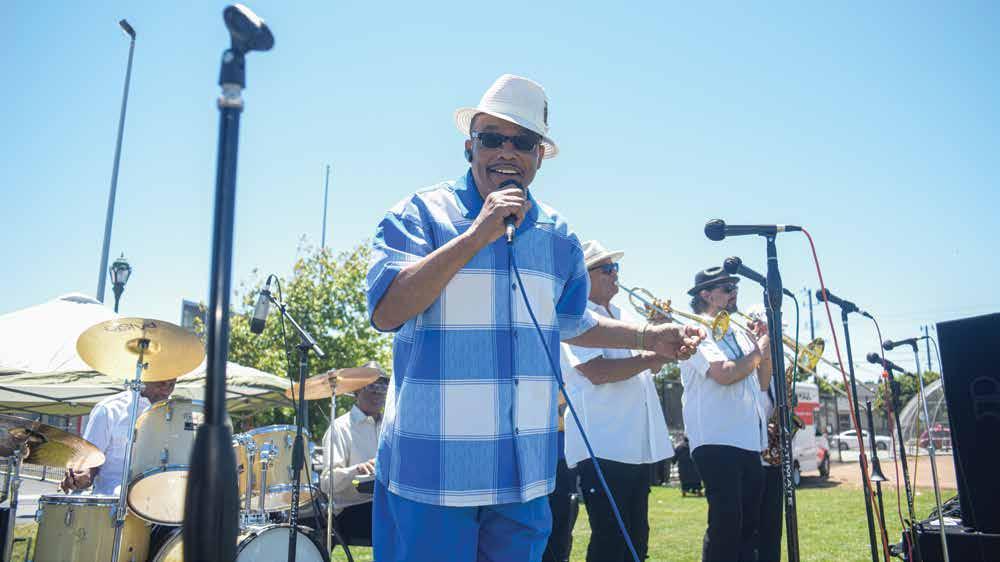
A gospel music tribute was also held to honor the late Richmond community member Kirtiss Phaye MageeWhite, who died this year.
Burkes, a blues singer who has lived in Richmond for more than 40 years, started the North and Greater Richmond Blues Foundation to honor the genre and its long history in the city, which she says can be traced
back to the 1940s.
Shields-Reid Park, the longstanding venue for the music festival, was filled with food vendors, a jumper, family activities and local community organizations participating in the event.
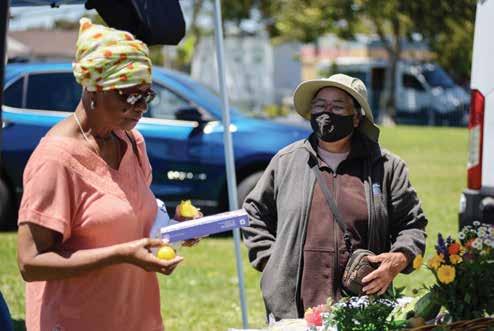
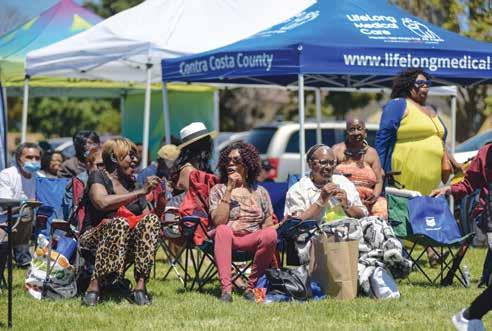
Among these organizations, some like Urban Tilth, have consistently supported the event year after year. Similarly, many attendees have made it a tradition to be present.
"This is like a homecoming," said Cynthia Jordan, a committee member of the North Richmond Music Festival, who has been volunteering for the festival since its inception.
This year was no exception as Jordan enjoyed the event with food, dance, people and music.
Jordan said she’s seen the neighborhood change from a predominantly Black community that was deeply tied into the music scene in North Richmond to a Latino population that doesn't historically attend the North
and Greater Richmond Blues Foundation events, like the North Richmond Music Festival, in mass.
According to Richmond Confidential, Richmond's population has undergone significant changes, with African Americans making up nearly half of the residents in 1980 but only 18% of the population in North Richmond by 2020.



"North Richmond is predominantly Hispanic, but this is a Black crowd," Jordan said while proudly observing the people she personally invited. "Many of the (attendees) no longer live in Richmond but grew up in North Richmond."
The music festival can be a reunion for some, like Jordan, and a time to revel in the longstanding tradition of the Black music community bringing blues and soul to North Richmond year after year. •
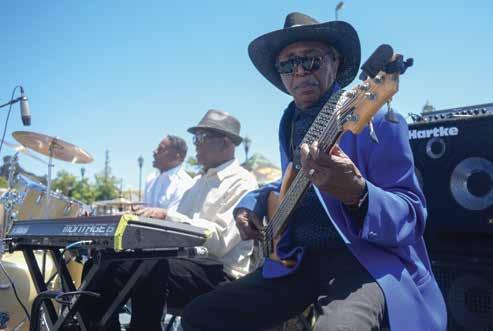

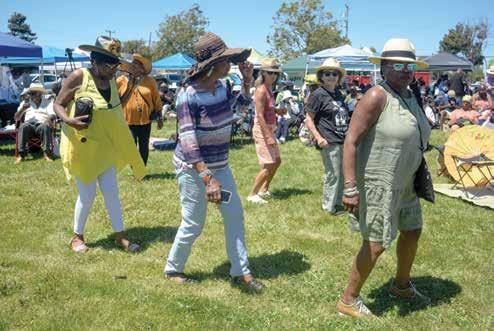
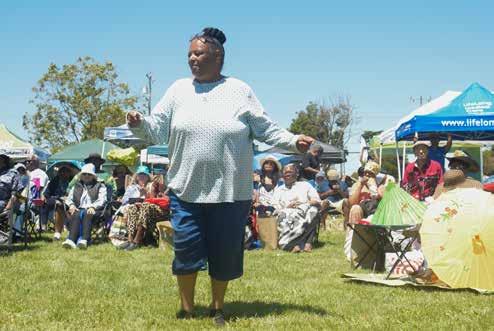
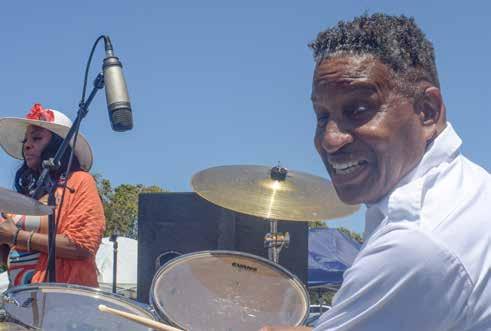
 BY SASHA ABIGANA
BY SASHA ABIGANA
Sometimes, when we try to give my grandma her pills, she thinks we’re trying to poison her.
For almost 10 years, my grandma has lived with my family and me because she can no longer live independently. Now, I’m used to having her in my life every day and caring for her, but before that, she would only visit once a year. Then, one day, everything changed so quickly.
I still recall the day of Feb. 13, 2014. I was only 7 years old. It was an ordinary day: I went to school, then to the Boys & Girls Club, and everything was good. Then, unexpectedly, my parents came to pick me up and told me we were heading to Daly City.
I was bewildered, and my mother was sobbing. She said my grandmother had fallen. I didn’t understand what was going on because I was so young; I assumed she had tripped or something, and I was curious as to why there was such a big deal. Then, my mother told me she had fallen from her two-story apartment while attempting to climb into a window, landing headfirst.
They wouldn’t let me into her hospital room. Before I saw her injuries, I had no idea how serious it was. Then, my family finally agreed it was time to let me visit her. As I entered the hospital room, I could hear her coughing. She was hooked up to machines, and her face was broken and extremely swollen. She also had a tube in her throat. She was in a coma and was not conscious of what was happening to her at the time.
Fast-forward a few years, and now my grandma lives with us. She has ever since her accident because she can’t take care of herself anymore.
Both my parents work, so I have always been the one to look after her. I’m the only girl with three brothers, so I have also always been the one to have to take my mother’s role when she wasn’t there. When my youngest brother was born, it felt like I had to take care of two
Continued from page 1
me to blood sweat and tears. I threw up multiple times in this program; I sweated, cried and bled from different body parts, but it was definitely something that changed me,” Cea said. “I realized that I am able to push my limits if I work hard enough. It showed me a lot about myself as a person.”
Leonardo Daniel Alvarez, an 18-yearold recent high school graduate, said this program teaches students to build leadership skills and discipline. He and Cea said they will pursue careers as firefighters.
Ed Medina, retired Richmond deputy police chief and director of operations of the academy said, “The students come in and they are really nervous. They are not sure what is going on; they are used to the classroom environment. But with the direct approach, especially from Carmen Santana, they learn very quickly that their job is to participate, to speak up, and slowly but surely start to work as a team. They gain confidence in themselves that they can then apply to any career.”
This was the first graduation of the Youth Public Safety Academy, but Santana hopes it won’t be the last. She wants to get more funding and bring in additional mentors to expand it to all the high schools in the district.
Valerie Estrada of the Richmond After School Program, who helped coordinate with YPSA, said, “There are great things happening at Richmond High. We are also coordinating with other career leaders to come and expose students to the many career possibilities.” •
children, running to both my grandma and my brother every time they cried and giving up my childhood to take care of them. This has left me feeling sort of overwhelmed because so many people have been dependent on me. My parents, my grandmother and my brother don’t even realize how much I have done for them.
It can be frustrating, but I have learned a lot from it. Over the years, I learned things while taking care of my grandma without really even realizing it. There are many skills that come along with caring for someone, but the major lesson I learned is patience and how much more strength that exhibits than responding angrily. I also gained a lot of practical knowledge, such as how to do hair, cook, compromise and even persuade. So in a way, I feel that taking care of others taught me to take care of myself and, in a way, I raised myself.
Taking care of my grandmother, who is 80, can also be tough because she has dementia, a brain condition that, for her, has caused memory loss, confusion, personality changes and even paranoia. I don’t know for sure if her accident or her age caused it.
It can be challenging to argue with my grandmother at times because she often thinks things that are nonsensi-
Continued from page 2
received as an out gay woman during your tenure on City Council affect your perception and willingness to serve the city?
JB: I have to say, initially, it was really discouraging hearing some of the vitriol that I received because some of it came from folks who consider themselves leaders in the Black community in Richmond. I stayed here and I stayed on the council and I am encouraged because Richmond came out in force to show the world that that level of intolerance would not be tolerated in our city. And so it really heartened me and really affirmed that I live in the best city in the East Bay.
Continued from page 3
public of this opportunity.

Fields that are not under city control, such as WCCUSD facilities, offer local alternatives for soccer organizations. WCCUSD and Richmond have an agreement for sports field usage between the city and the district; however, independent soccer organizations cannot currently benefit from this agreement. Only city-sponsored groups are able to use these alternatives.
The next regular Richmond City Council meeting is Sept. 12 as the council takes a summer break. •
cal. Sometimes, she doesn’t know who I am. She doesn’t fully realize that she can’t accomplish everything by herself and frequently becomes irate when I take over. She will attempt to cook and clean on her own and inevitably make a mess.
She also doesn’t understand why she is with us. My little brother was born two years after she fell and came to live with us. But she believes she just came to visit to see the new baby and now we are holding her hostage. It’s annoying because no matter how many times I tell her, she will either forget or refuse to believe me.
Not every day is challenging with my grandma, but there are times when she is extremely paranoid and refuses my care, believing that I’m trying to harm her. For example, when I try to give her pills, some days she will take them without asking, and other days she will refuse, saying that they are poison. I have to reassure her that she will be OK, but she just doesn’t believe me, which is really challenging.
She can be especially stubborn about it because she believes God is on her side. She has told us that the Lord was going to knock at the door and tell us we’re wrong. I’m still waiting for him to knock. •
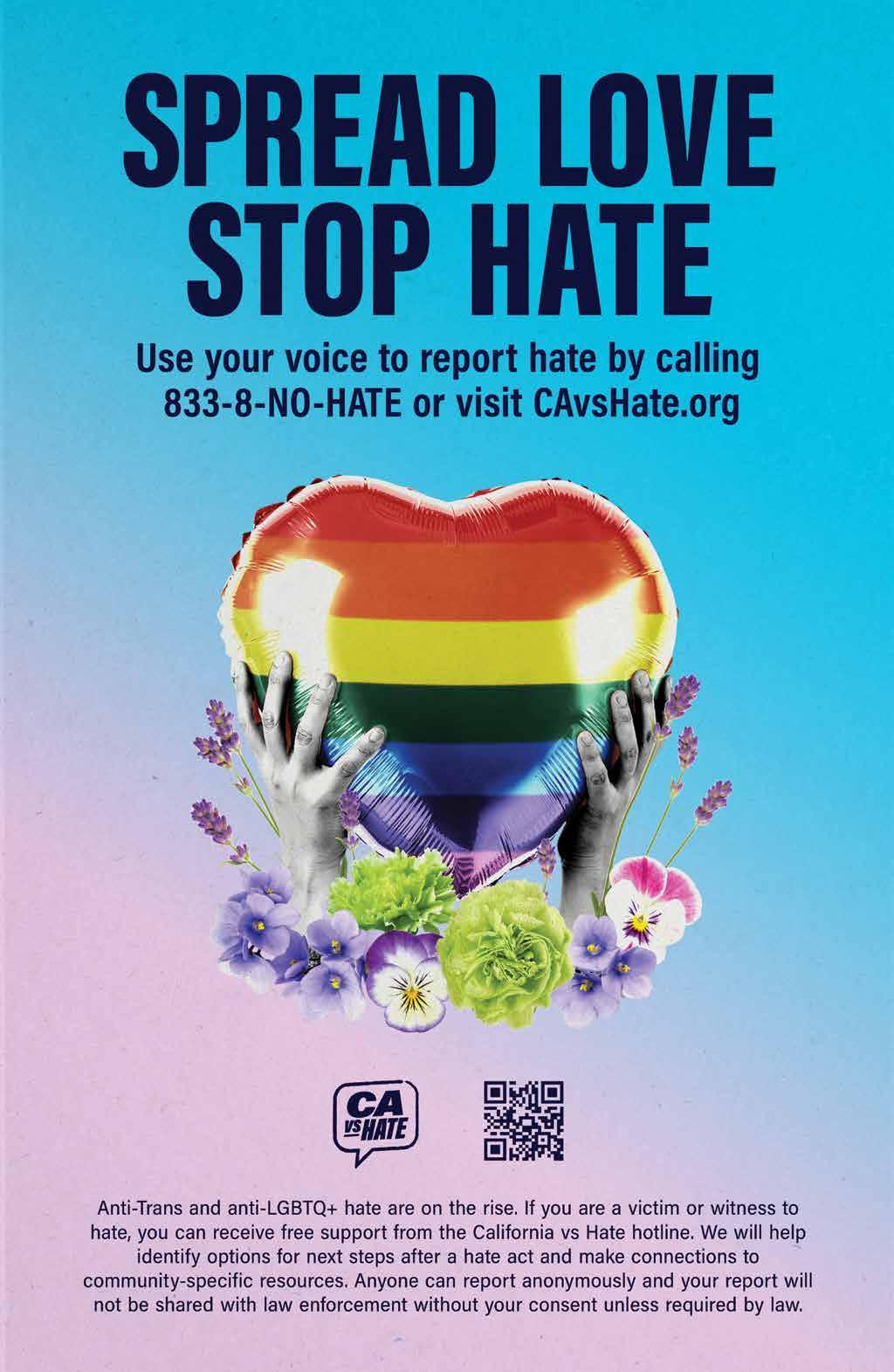
Editor’s note: This is part one in a series about Contra Costa Animal Services and pet adoption. In this first chapter, we take a look at overcrowding in the shelter and the deadly consequences it can have.
A vacant dog kennel at Contra Costa Animal Services is a rarity.
CCAS has offered free adoptions in June and July in an effort just to reduce overcrowding at its shelter in Martinez.
In just the first five months of this year, CCAS has already taken in 1,382 dogs. Of those, 106 have been euthanized.
In May, 33 dogs were euthanized in only 31 days.
Overcrowding and euthanasia are common problems for Bay Area shelters.
For example, Oakland Animal Shelter took in 2,852 dogs in 2022, 157 of which were euthanized.
“When you look at other public shelters, we’re proud of our ability to save animals,” said CCAS public information officer Steve Burdo.
The dilemma stretches countrywide and beyond dogs.
Every year, an average of 3.1 million dogs enter the 14,000 shelters and rescue groups throughout the U.S. But that’s only the beginning.
According to Spots.com, 4,000-10,000 animals are euthanized daily in shelters, and 25% of animals entering shelters are confirmed euthanized.

In 2019, California passed Texas as the state with the highest euthanasia rate.
The veterinarians euthanizing animals themselves are also affected, with a suicide rate 2.8% higher than the general population.
Some dogs are euthanized due to behavioral issues (such as aggression) that are said to make them unfit for domestic life; others, to end suffering caused by depression or incurable medical problems.
Though, Spots.com indicates 90% of euthanized animals are adoptable and that 75% of people think euthanizing a healthy animal should be illegal.
Irina Dyatlovskaya helps dogs by connecting them with fosters, partaking in fundraisers, creating awareness on social media, and speaking at Contra Costa Board of Supervisors meetings.
Dyatlovskaya said CCAS sometimes wrongly labels dogs as aggressive, leading to undeserved euthanasia.
“It’s not aggression; it’s fear. Dogs are put on the ‘kill
Like many schools in California, poor facility conditions in the West Contra Costa Unified School District create an environment that is unsafe and hinders learning.
The WCCUSD school board received an annual update of the Facilities Master Plan and summer projects at its July 12 meeting. The update shows already improved facilities and future sites the district will be working on.
Clerk Jamela Smith-Folds said a school’s facilities are one of the most important things students use.
list’ just for being scared,” she said. “They’re just trying to protect themselves…Imagine your own dog in that situation.”
According to Wendy Wolf, an ex-CCAS employee who coordinates with rescue groups and interacts with shelter personnel frequently, “they (CCAS) use catch poles, bring dogs into a loud, scary place, then if the dog growls at them, it’s labeled aggressive, and the designation never leaves them.”
The dogs are also labeled things such as, “timid” and “unable to be handled.”
Ward acknowledged that CCAS cannot reproduce a domestic setting, no matter how hard it tries.
“Dogs aren’t meant to be held in a kennel for any length of time, really — they want to be with people,“ she said. “When we get overcrowded, it becomes harder on the animals because it gets more stressful, and you see potential illnesses increase or behaviors decline.”
She added that dogs’ heightened senses are overloaded by things like the smells of other dogs and loud echoing throughout the tile-floored building.
Wolf went on to say that a lack of information provided by CCAS — like “bite incident,” without details — unless asked for, could change an adopter or rescuer’s mind about taking a dog.
“Most rescuers have other jobs and don’t have extra time to ask questions,” she said.
According to Ward, all notes made on dogs at CCAS are crucial.
“The notes do stay with an animal because they’re important to know… when the dog goes into a new environment we can be careful about how they’re introduced,” she said.
Burdo said it partly takes the direction of their field services captain and chief veterinarian to decide how a
dog is labeled.
“There’s a whole process we go through for designating an animal as dangerous,” he said.
According to Ward, shelter staff bring their information on dogs to a rounds committee overseen by herself, the chief veterinarian, and captain of field services to figure out what paths dogs should go on and continuously reevaluates.
Dyatlovskaya and others critical of CCAS cite the No Kill Movement, which has been successfully implemented at shelters around the country where animals are not euthanized.
The movement is headed by Nathan Winograd, whose No Kill Advocacy Center works out of Oakland.
Shelters can be technically labeled as “no kill” if under 10% of their animals are euthanized annually.
Opponents of the movement point to dogs being kept alive under cruel circumstances, sometimes going “kennel crazy,” which involves endlessly spinning or smearing feces.
“While there’s very positive aspects of the ‘no kill’ movement, because I believe we really wouldn’t be where we are today in the industry if we didn’t have that, it did create a divide between the municipal and the nonprofit shelters because of intake policies and practices, et cetera,” said Ward.
Last year, CCAS euthanized 12% (229) of the dogs surrendered.
The “no kill” designation is nothing new to the Bay Area. In 1994, San Francisco became the first city to be considered “no kill” as a whole.
To find out more adopting an animal, visit contracosta. ca.gov/804/adoptions or 24petconnect.com to look beyond Contra Costa County. •
“They need to feel as if they are taken care of from the inside out,” Smith-Folds said. “We should not take for granted how powerful having a good school building to go to (is).”
The 23 projects that are part of the facilities master plan include complete demolition, renovation and soil testing. Only 10 projects must finish going through planning or construction.
Nearly 40% of students in California schools learn in facilities that don’t meet state standards. California’s Office of Public School Construction provides schools with the facility inspection tool that can be used to evaluate the condition of a facility. There are 15 categories staff evaluate within the tool, including cleanliness, structural and safety, of which eight are included in a school’s accountability report card.
Some WCCUSD schools that are on the list for future projects, like Stege Elementary School, receive poor ratings in categories and complaints from staff, students and parents, but still receive a fair facility rating.
Stege, which the board identified as being one of the schools most in need of renovation, is planned to undergo demolition to make way for site improvements in the future. But, even though this need was identified, Stege is one of the last projects left.
Luis Freese, associate superintendent for opera-
tions, said projects are prioritized based on a number of things. The conditions of school sites, maintenance surveys and district need are used to determine which project goes ahead of another. In addition, other projects identified by the operations department are sometimes prioritized. This year, for example, the department is working on play structures at 10 school sites.
Two of Richmond’s high schools, Kennedy High and Richmond High, are among the schools that have planned projects for their sites. In the fall, staff will return to the board to recommend phasing and scope for construction.



President Demetrio Gonzalez-Hoy, Trustee Leslie Reckler and Smith-Folds said keeping community members informed of projects is important.
Gonzalez-Hoy said he often gets questions from the public on the status of the projects at Kennedy High, Richmond High and Stege Elementary. He said many of them also ask how they can get involved in the process.
"Community members can sign up for WCCUSD’s operations department’s construction electronic newsletter by visiting https://forms.gle/NL3B5ZBcSPZ5GZSA8.•